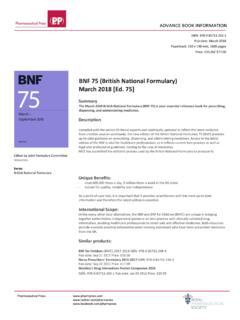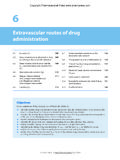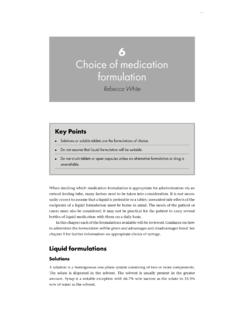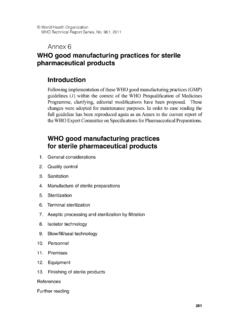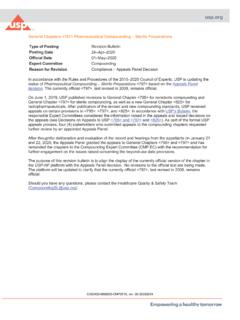Transcription of chapter 1 Pharmaceutical solutions for oral administration
1 General descriptionPharmaceutical solutions may be generallydefined as liquid preparations in which thetherapeutic agent and the various excipientsare dissolved in the chosen solvent solutions may contain arange of excipients, each with a definedpharmaceutical purpose. Examples of theseinclude: the vehicle, usually purified water co-solvents, propylene glycol,glycerin, alcohol agents specifically to enhance the solubility of the therapeuticagent in the vehicle, surface-active agents preservatives, parahydroxybenzoate esters (methylhydrox-ybenzoate and propylhydroxybenzoate), boric acid and boratesalts, sorbic acid and sorbate salts, phenolics sweeteners, glucose, saccharin, aspartame rheology (viscosity) modifiers, hydrophilic polymers(cellulose derivatives, alginic acid, polyvinylpyrrolidone)
2 Antioxidants, sodium formaldehyde sulphoxylate,butylated hydroxyanisole, butylated hydroxytoluene colours flavours buffers to regulate the pH of the formulation, specific roles of each of these formulation excipients will bedescribed later in this 1 Pharmaceutical solutionsfor oral administrationIn this chapter we will: examine the types and uses of Pharmaceutical solutions as oral drug delivery systems provide an overview of the advantages and disadvantages of Pharmaceutical solutions asoral drug delivery systems describe the formulation considerations for orally administered Pharmaceutical Pharmaceutical solutions areextensively used as dosage formsfor the oral administration oftherapeutic agents. Pharmaceutical solutions arehomogeneous, the therapeuticagent(s) and excipients aredissolved in the vehicle.
3 Pharmaceutical solutions for oraladministration are in non-steriledosage chapter 1644 7/5/08 10:41 Page 1 Advantages and disadvantages of pharmaceuticalsolutions for oral administrationAdvantages Therapeutic agents can easily be administered orally toindividuals who have difficulty in swallowing, elderlypatients, infants. The therapeutic agent is dissolved in the formulation and istherefore immediately available for absorption. Providing thedrug does not precipitate within the gastrointestinal tract, thebioavailability of Pharmaceutical solutions is greater than thatof oral solid-dosage forms. Taste-masking of bitter therapeutic agents may be Pharmaceutical solutions for oral administration areunsuitable for therapeutic agents that are chemically unstablein the presence of water.
4 The poor solubility of certain therapeutic agents may prohibittheir formulation as Pharmaceutical solutions . The readershould note that certain techniques are available to enhancethe solubility of poorly soluble drugs. These will behighlighted later in this chapter . Pharmaceutical solutions are expensive to ship and are bulkyfor the patient to carry due to the associated mass of solubilityIn Pharmaceutical solutions both the therapeutic agent and theexcipients are legally required to be present in solution over theshelf-life of the formulated product. As a result pharmaceuticalsolutions are termed homogeneous. One of the major challengesto the Pharmaceutical scientist is the attainment of homogeneityin the formulation, due primarily to, in many cases, the limitedaqueous solubility of the therapeutic agent.
5 Initially there arepossible scenarios regarding the formulation of pharmaceuticalsolutions of a therapeutic agent for oral administration : The aqueous solubility of the therapeutic agent is high at theselected pH of the formulation. Under these circumstancesthe therapeutic agent may be readily incorporated into thevehicle and formulated as an oral solution. The aqueous solubility of the therapeutic agent is moderate atthe selected pH of the formulation, the aqueous solubilityis less than the requested concentration of therapeutic these circumstances the solubility of the therapeutic2 Pharmaceutics: Dosage Form and Design01 chapter 1644 7/5/08 10:41 Page 2agent in the formulation must be enhanced using co-solventsand related methods. The aqueous solubility of the therapeutic agent is low at theselected pH of the formulation.
6 The difference between theaqueous solubility of the therapeutic agent and the requiredconcentration is too great to be bridged by the use of co-solvents and related methods or the concentration of co-solvents or surfactants in the solubilised formulation may betoxic when administered orally. The drug may therefore beformulated as an alternative-dosage form, a to discussing the solubility of therapeutic agents andformulation strategies to modify this property, it is worthconsidering the process of drug dissolution. The dissolution of atherapeutic agent in water involves several key molecular steps:the removal of a molecule of the drug from the solid state, theformation of a cavity within the solvent and the accommodationof the drug molecule into the formed cavity.
7 This process involvesthe breakage of solute solute and solvent solvent bonds(endothermic processes) and the formation of a bond between thesolute and the solvent (with the subsequent liberation of energy).Dissolution occurs whenever the Gibb s free energy ( G) of theprocess is negative and involves a balance between the enthalpyof dissolution ( H) and the associated entropy ( S) at thetemperature of dissolution (T), as defined below: G H T SFactors affecting the solubility of therapeutic agentsThe solubility properties of drug molecules in a particular solventsystem are sometimes difficult to predict and have been reportedto be dependent, at least in part, on several physicochemicalproperties, including molecular weight, volume, radius ofgyration, density, number of rotatable bonds, hydrogen bonddonors and hydrogen bond acceptors.
8 Furthermore, the propertiesof the solid state, crystal habit, crystalline/amorphousproperties, will also affect the solubility of the therapeutic agent. There are some empirical relationships between thephysicochemical properties and the solubility of therapeuticagents that influence formulation strategies, as follows: The solubilities of a chemically related series of therapeuticagent are inversely related to their melting points. Therefore,as the melting point of the therapeutic agent is increased, thesolubility would be expected to decrease. The solubility of a therapeutic agent is directly affected byboth the type of chemical substituent groups and thesubstituent position. The solubility of therapeutic agents3 Oral Pharmaceutical solutions01 chapter 1644 7/5/08 10:41 Page 3containing hydrophilic groups ( OH, COO , ammoniumion) will accordingly be greater than those containinglipophilic substituent groups, methyl, ethyl, ethoxy orchlorine groups.
9 The solubilities of therapeutic agents that are either acids orbases (representing the vast majority of drug substances) arepH-dependent. The solubility of acids and bases increases asthe degree of ionisation increases and may be easily calculatedusing the following equation (where Srefers to the solubilityof the drug and Sois the intrinsic solubility, the solubilityof the unionised form of the drug).pK pKa logS Sofor acids(So)pH pKa logSofor bases(S So)From these equations two invaluable conclusions may bedrawn: At pH values abovethe pKa, the solubility of acidic drugsincreases. At pH values belowthe pKa, the solubility of basic simple terms the solubility of acidic compounds increasesas the pH of the solution is increased (above the pKa) and thesolubility of basic compounds increases as the pH is loweredbelow the of the solubility properties of zwitterioniccompounds, those that exhibit both acidic and basicproperties, is more complicated than for simple acids or , in common with simple acids and bases, the solubilityof zwitterionic therapeutic agents is affected by pH.
10 At basic pHvalues the therapeutic agent behaves primarily as an acid whereasat low pH values the molecule behaves as a base. The pH range atwhich the therapeutic agent exhibits minimal solubility liesbetween the pKa values of the acidic and basic methods to enhance/optimise the solubilityof therapeutic agentsThe information described below may be employed to optimisethe formulation of Pharmaceutical solutions , remembering that theprerequisite for Pharmaceutical solutions is the exclusivepresence of dissolved therapeutic : Dosage Form and Design01 chapter 1644 7/5/08 10:41 Page 4 Appropriate selection of drug saltThe reader will be aware that the majority of therapeutic agentsare commercially available to the Pharmaceutical scientist in arange of salt forms, each form exhibiting a different aqueoussolubility.





